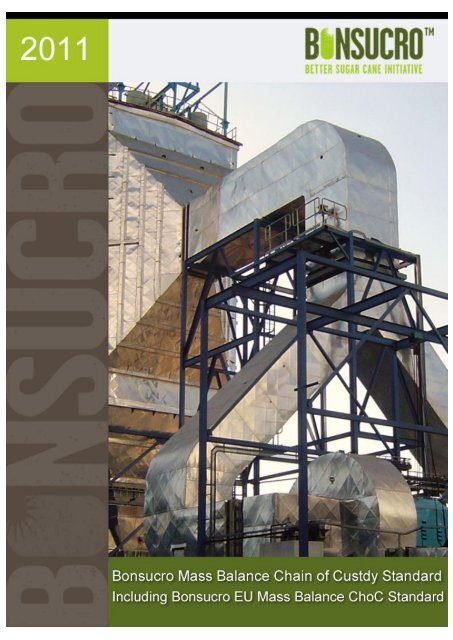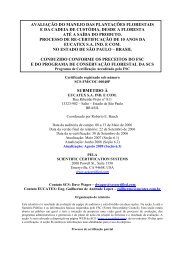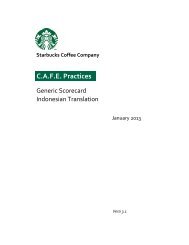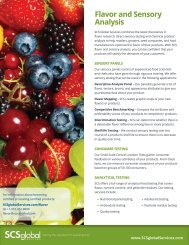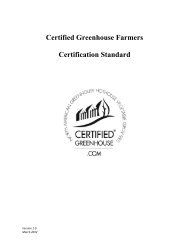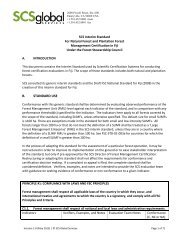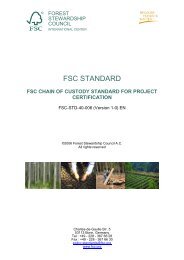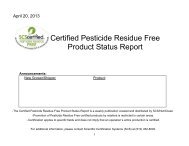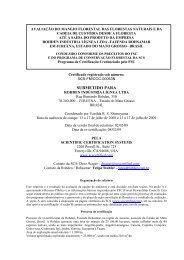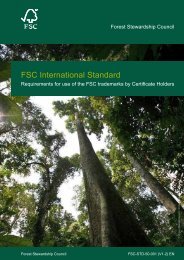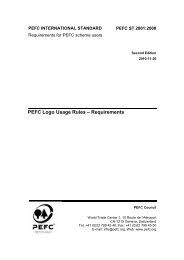CHAIN OF CUSTODY STANDARD - SCS Global Services
CHAIN OF CUSTODY STANDARD - SCS Global Services
CHAIN OF CUSTODY STANDARD - SCS Global Services
You also want an ePaper? Increase the reach of your titles
YUMPU automatically turns print PDFs into web optimized ePapers that Google loves.
BONSUCRO MASS BALANCE <strong>CHAIN</strong> <strong>OF</strong> <strong>CUSTODY</strong><strong>STANDARD</strong>INCLUDING BONSUCRO EU MASS BALANCE<strong>CHAIN</strong> <strong>OF</strong> <strong>CUSTODY</strong> <strong>STANDARD</strong>Better Sugar Cane Initiative Ltd ('Bonsucro')*Version 3.0 March 2011HISTORY <strong>OF</strong> THE DOCUMENTThe first version of this Chain of Custody Standard for the Mass Balance System was set upin June 2010 and sent around for socialization to the members of the Bonsucro EU SubCommittee.The revised version was reviewed by the Bonsucro Management Committee on July 6, 2010and adopted by the Management Committee on July 27, 2010.In December 2010 and in March 2011 this version was revised based on feedback receivedfrom the EU on the level of compliance of the Bonsucro Certification System with EU REDrequirements as well as feedback received from the first pilot audits and training.Consultants on the project for Bonsucro in the development of this Chain of CustodyStandard have been: NewForesight and SGS.Revision round Date Description of amendmentA June 2010 Draft version send to Bonsucro EU Sub CommitteeB July 2010Final version approved by Bonsucro ManagementCommitteeC December 2010 Revision made based on compliance with EU REDD March 2011 Revision made based on compliance with EU REDBonsucro Mass Balance ChoC Standard – Version 3.0 March 2011Including Bonsucro EU Mass Balance ChoC Standard© Bonsucro 2011/Bonsucro EU 2011Page | 1
This document is a work in progress. Especially during the first year of implementation,Bonsucro encourages feedback with suggestions for overcoming difficulties and improvingthe process.This document is written in the English language. Bonsucro does not assume any liabilityfor errors or misunderstandings introduced when this document is translated into otherlanguages.* Bonsucro is a not for profit company limited by guarantee, registered in the UnitedKingdomTABLE <strong>OF</strong> CONTENTS1. Introduction ...........................................................................................41.1 Bonsucro ...................................................................................41.2 Bonsucro certification system ..........................................................41.3 Intent of this document..................................................................61.4 Introduction to content document .....................................................62. Scope ...................................................................................................72.1 Scope of Bonsucro Chain of Custody Standard for the Mass Balance System.....72.2 Certification requirements ..............................................................72.3 References .................................................................................82.4 Definitions and abbreviations ...........................................................83. Basic elements of the Chain of Custody standard ............................................. 103.1 Traceability .............................................................................. 103.2 Identification, traceability and verification of sustainability characteristics . 113.3 Control of mass balance system ...................................................... 123.4 Control of consignments ............................................................... 143.5 Control of mixes of consignments .................................................... 153.6 Control of splitting of consignments from mixtures ............................... 16Appendix 1: GHG calculation ........................................................................ 17Appendix 2: EU RED for the calculation of the ―el‖ value for annualized emission fromcarbon stock change cause by land use changes .................................. 24Appendix 3: monitor global warming emissions with a view to minimizing climate changeimpacts .................................................................................. 26Appendix 4: Minimum data assigned to consignments for Bonsucro compliance ............. 27Bonsucro Mass Balance ChoC Standard – Version 3.0 March 2011Including Bonsucro EU Mass Balance ChoC Standard© Bonsucro 2011/Bonsucro EU 2011Page | 2
Appendix 5: Additional data assigned to consignments for Bonsucro EU compliance........ 27Appendix 6: Principle of mass balance applied on Bonsucro compliant and Bonsucro EUcompliant ............................................................................... 28Appendix 7: Terms and definitions .................................................................. 29Bonsucro Mass Balance ChoC Standard – Version 3.0 March 2011Including Bonsucro EU Mass Balance ChoC Standard© Bonsucro 2011/Bonsucro EU 2011Page | 3
1. INTRODUCTION1.1 BONSUCROBonsucro is a global multi-stakeholder non-profit initiative dedicated to reducing theenvironmental and social impacts of sugarcane production. The mission of Bonsucro is toensure that current and new sugarcane production and all sugarcane derived products areproduced sustainably. Bonsucro aims to achieve this mission through designing andorganization the process of multi-stakeholder definition for sustainable sugarcaneproduction and all sugarcane derived products (i.e. ‗Standard Setting‘) and ensuring theintegrity of its implementation (i.e. ‗Certification‘).1.2 BONSUCRO CERTIFICATION SYSTEMThe Bonsucro Certification System consists of 3 main elements:1. Standards: Bonsucro has developed 2 standards:The “Bonsucro Production Standard” contains principles and criteria forachieving sustainable production from sugarcane and all sugarcane derivedproducts in respect of economic, social and environmental dimensions. Inaddition, the Production Standard contains a set of technical and administrativerequirements for enabling the tracking of claims on this sustainable productionof Bonsucro sugarcane and all sugarcane derived products in the cane supplyarea and in the milling operations including the transport of cane to the mill 1 .The “Bonsucro Mass Balance Chain of Custody Standard” contains a set oftechnical and administrative requirements for enabling the tracking of claims onthe sustainable production of Bonsucro sugarcane and all sugarcane derivedproducts along the entire supply chain after the mill and its cane supply;through production (e.g. conversion, processing, manufacturing,transformation), warehousing, transportation and trade to use of sugarcane andall sugarcane derived products.NOTE: Those Chain of Custody requirements that are applicable to the mill andits cane supply area are already included within the Production Standard andare identical to those of the Mass Balance Chain of Custody Standard.2. Audit Guidance: Bonsucro has developed guidance and clarification documents formembers and auditors on how to become compliant with the Bonsucro ProductionStandard and/or Chain of Custody Standard. This includes: 1.) description of how tointerpret the principles and criteria from the Bonsucro standards, 2.) auditinstructions to verify compliance through indicators and verifiers, 3.) informationrelated to exceptional situations, 4.) objective criteria for critical limits, and 5.)Tools and calculations for audit1 These requirements are identical to the requirements of the Bonsucro Mass Balance Chain of Custody Standard.Bonsucro Mass Balance ChoC Standard – Version 3.0 March 2011Including Bonsucro EU Mass Balance ChoC Standard© Bonsucro 2011/Bonsucro EU 2011Page | 4
3. Certification Protocol: Bonsucro has developed a Certification Protocol for membersand auditors that lists the process and procedures for certification against theBonsucro standards. This includes: 1.) rules and requirements for Certification Bodiesto audit against the Bonsucro standards, 2.) certification requirements for economicoperators to demonstrate compliance to the Bonsucro standards, and 3.) auditprocedures for Certification Bodies to verify compliance with the Bonsucro standards.Together these 3 elements form the Bonsucro Certification System. As such, theseindividual documents can never be used as stand-alone documents and must always beused in relation to each other.The scope of the Bonsucro Certification System can be with or without compliance to EURenewable Energy Directive (RED) and its similar provisions in the EU Fuel Quality Directive(FQD). As such, the Bonsucro Certification System makes a distinction between 2 mainscopes:1. ―Bonsucro‖: compliant with Bonsucro requirements2. ―Bonsucro EU‖: compliant with Bonsucro requirements PLUS additionalrequirements that are needed for EU RED complianceWithin the Bonsucro Certification System documents (i.e. Standards, Audit Guidance, andCertification Protocol) the extra Bonsucro EU requirements are clearly marked. Both theBonsucro scope and the Bonsucro EU scope form part of the overall ‗Bonsucro CertificationSystem‘ and will be referred to as such from here onwards.For compliance with the Bonsucro EU scope ALL requirements need to be met (e.g.Bonsucro PLUS additional EU RED requirements). Bonsucro EU certification is equivalent toBonsucro certification. Whereas the contrary does not apply; Bonsucro certification is notequivalent to Bonsucro EU certification. Members that do not wish to become Bonsucro EUBonsucro Mass Balance ChoC Standard – Version 3.0 March 2011Including Bonsucro EU Mass Balance ChoC Standard© Bonsucro 2011/Bonsucro EU 2011Page | 5
compliant are excluded from this Bonsucro EU scope extension and do not have to complywith the additional EU RED requirements1.3 INTENT <strong>OF</strong> THIS DOCUMENTThe intent of this Bonsucro Chain of Custody Standard for the Mass Balance System (furtherChoc) is in addition to the Bonsucro Principles and Criteria (P&C) to provide a voluntaryinternational scheme that covers key economic, environmental and social considerations inorder to produce sugarcane products, including biofuels and bioliquids world wide in asustainable matter‖. This Choc is especially designed for use in the entire supply chain ofsugarcane, products and by products of sugarcane, bioliquids and biofuel produced fromsugarcane. In the supply chain there is a need for both suppliers and clients in every ―link‖of the chain to demonstrate and claim compliance with sustainability criteria. Theverification of compliance with EU sustainability criteria needs to follow the mass balancesystem.Those Chain of Custody requirements that are applicable to the mill and its cane supplyarea have been included within the Production Standard and are identical to those of thisMass Balance Chain of Custody Standard.In addition there has been identified a need for demonstrating compliance with therequirements of the EU Renewable Energy Directive ( EU RED) also identified as Directive2009/28/EC and with the EU Fuel Quality Directive (2009/30/EC).‖ Both of these EUdirectives contain the same sustainability criteria, therefore it is considered practical thatthis standard refers to EU RED only as far as the sustainability criteria are concerned.1.4 INTRODUCTION TO CONTENT DOCUMENTThe chapters of this document are based on the ―Bonsucro Chain of Custody Standard forthe Mass Balance System‖ elements and are worked out in criteria specifying therequirements.In the document references are made to definitions, abbreviations, tools and annexes aslisted in the Bonsucro Certification Protocol that can be used within the entire Bonsucrocertification system and that are standardised with EU RED definitions and vocabulary.Specific definitions for this document have been added. Where possible annexes that areapplicable on both the Bonsucro Principles and Criteria and this Choc are put in thereference list. New annexes have been added to explain the consignment mixtures andsplit. The Mass Balance System and the format for the (minimum requirements)specification of sustainability characteristics and GHG Emission Claims to consignments.Bonsucro Mass Balance ChoC Standard – Version 3.0 March 2011Including Bonsucro EU Mass Balance ChoC Standard© Bonsucro 2011/Bonsucro EU 2011Page | 6
2. SCOPE2.1 SCOPE <strong>OF</strong> BONSUCRO <strong>CHAIN</strong> <strong>OF</strong> <strong>CUSTODY</strong> <strong>STANDARD</strong> FOR THE MASSBALANCE SYSTEMThe unit of certification will be all economic operators after the mill and its cane supplybase who take legal ownership of the Bonsucro certified sugarcane products and/or allsugarcane products derives thereof. Those Chain of Custody requirements that areapplicable to the mill and its cane supply area have been included within the ProductionStandard and are identical to those of this Mass Balance Chain of Custody Standard.Therefore mills and their cane supply area only need to comply with the ProductionStandard and the unit-of-certification for this Chain of Custody Standard starts after themill.This Chain of Custody Standard offers 2 scopes for certification:1. ―Bonsucro‖: compliant with Bonsucro requirements2. ―Bonsucro EU‖: compliant with Bonsucro requirements PLUS additionalrequirements that are needed for EU RED complianceWithin this Standard the additional Bonsucro EU requirements are clearly marked as such.For compliance with the Bonsucro EU scope ALL requirements need to be met (e.g.Bonsucro PLUS additional EU RED requirements). Bonsucro EU certification is equivalent toBonsucro certification. Whereas the contrary does not apply; Bonsucro certification is notequivalent to Bonsucro EU certification. Members that do not wish to become Bonsucro EUcompliant are excluded from this Bonsucro EU scope extension and do not have to complywith the additional EU RED requirements2.2 CERTIFICATION REQUIREMENTSNo public claims relating to compliance of Bonsucro and/or Bonsucro EU certifiedsugarcane and all sugarcane derived products with the Bonsucro standard can be madewithout valid certification against the Bonsucro Certification System by an accreditedCertification Body that is approved by Bonsucro to perform audits under the BonsucroCertification System. Only after certification are economic operators allowed toparticipate in the scheme and buy and sell certified sustainable material and claim it assuch.Verification of compliance with this Chain of Custody standard needs to follow the ―Massbalance system‖. This Chain of Custody standard contains specific requirements for thecontrol of a mass balance system that is in conformance with the EU legislativerequirements. The mass balance system is an accounting system to show the balancebetween input and output of sustainable sugarcane and all sugarcane derived products.In order to achieve compliance with Bonsucro Chain of Custody Standard, 80% of theBonsucro Mass Balance ChoC Standard – Version 3.0 March 2011Including Bonsucro EU Mass Balance ChoC Standard© Bonsucro 2011/Bonsucro EU 2011Page | 7
indicators contained in Elements 3.1 to 3.6 must be satisfied. In this, the specific BonsucroEU requirements can be excluded from the scope (and thus compliance).In order to achieve compliance with the Bonsucro EU Chain of Custody Standards, 80% ofthe indicators contained in Elements 3.1 to 3.6 must be satisfied. In addition, there are anumber of Major Elements (3.2.3, 3.2.4, 3.3.3, 3.3.4, 3.3.5, 3.4.1) which must be satisfiedbefore compliance will be considered.2.3 REFERENCESThe Bonsucro Certification Protocol has been established based on the followingreferences:a) ISO 9000: 2005 quality management terms and vocabularyb) ISO 9001:2008 quality management systemc) ISO 19011: 2002 quality- and environmental management system‘s auditingd) ISO IEC Guide 65/EN 45011e) ISO Draft IEC Guide 17065f) ISO 14065:2007,IDT ―Greenhouse gases- Requirements for greenhouse gas validationand verification bodies for use in accreditation or other forms of recognition‖g) Draft ISO IEC Guide 17065h) ISO 14065:2007 IDTi) ISO 14064-3:2006j) ISEAL procedure P035 on Group Auditingk) EU RED 2009/28/EC and EU FQD 2009/30/EC directives, definitions andabbreviationsl) 2010/335/: EU Commission Decision of 10 June 2010 on guidelines for thecalculation of land carbon stocks for the purpose of Annex V to Directive2009/28/EC OJ L 151, 17.06.2010m) Communication from the EU Commission on voluntary schemes and default values inthe EU biofuels and bioliquids sustainability scheme OJ C 160, 19.6.2010n) Communication from the EU Commission on the practical implementation of the EUbiofuels and bioliquids sustainability scheme and on counting rules for biofuels OJ C160, 19.6.20102.4 DEFINITIONS AND ABBREVIATIONSChain of custody (choc): the supply chain of a product including all stages from thefeedstock production up until the release of the product for consumption (RE:communication from the commission on voluntary schemes)Client: next legal owner of the product in the choc.Consignment: quantity (e.g. batch, lot, load) of product mass with unique identification #and attached data specifying the product content in terms of kg (or tons of sugar or litres(or m 3 ) of ethanol, the sustainability characteristics and greenhouse gas emission valuesassigned to that quantity in terms of EU RED annex VBonsucro Mass Balance ChoC Standard – Version 3.0 March 2011Including Bonsucro EU Mass Balance ChoC Standard© Bonsucro 2011/Bonsucro EU 2011Page | 8
3.2 IDENTIFICATION, TRACEABILITY AND VERIFICATION <strong>OF</strong> SUSTAINABILITYCHARACTERISTICSThe sustainability criteria are listed in the Bonsucro production standard and are incompliance with the EU RED art. 17. For each consignment at any stage of the chain ofcustody sustainability characteristics need to be identified and assigned to theconsignment.Criteria Indicator Standard Notes3.2.1 Each consignment has aunique identification #> =90% identified The identification can beboth physical andadministrative and in thatcase needs to be identicalIt is allowed to have onlyadministrative control of3.2.2 Each consignment containsa specification with at aminimum the data specifiedin Appendix 43.2.3Bonsucro EU3.2.4Bonsucro EUConsignments clearlyspecify the scope ofcompliance:Non compliantBonsucro compliantBonsucro EU compliantEach Bonsucro EU compliantconsignment contains aspecification with at aminimum the data specifiedin appendixes 4 and 5. GHGemissions figures must becalculated according tospecifications laid down inappendixes 2 and 3.>= 90% withspecificationMajorNo false claimsEg. non compliantmay not show upas compliant orBonsucrocompliant maynot show up asBonsucro EUcompliantMajorconsignmentsWhen a next owner isaccepting ownership for aconsignment withoutspecification or incompletespecification he takesresponsibility to supply thisinformation by himselfBy taking ownership overconsignments that are noncompliant the owner takesfull responsibility over theconsignment and needs toprovide evidence ofcompliance before a claim ofcompliance can be madeOnly for option Bonsucro EUin addition to the above datafor BonsucroBonsucro Mass Balance ChoC Standard – Version 3.0 March 2011Including Bonsucro EU Mass Balance ChoC Standard© Bonsucro 2011/Bonsucro EU 2011Page | 11
3.3 CONTROL <strong>OF</strong> MASS BALANCE SYSTEMThe mass balance system, according to article 18 of the EU RED means a system in which―sustainability characteristics‖ remain assigned to ―consignments‖ and evidence showingcompliance with these characteristics are required and need to be documented andrecorded. See Appendix 6 for principles.The mass balance system must be controlleda) in periods of time in which the balance of Bonsucro certified sustainable productversus not sustainable product should be equal or positive at the moment ofbalance. Evidence of balance must be recorded and must be verifiable by periodicbalance reports over that particular period, showing all inputs, mixes, conversions,stocks and outputs.The accounting year for Mass Balance includes a full annual harvest cycle, which is notallowed to be divided over 2 accounting years.Criteria Indicator Standard Notes3.3.1 The accounting system forthe control of the massbalance is documented andmass balance records anddata are maintained on adaily base and verifiable>= 90 % validatedwithin 1 weekThe economic operator may collectdata and records within intervals asdocumented in procedures on sitebefore entering these in theaccounting system; data must beupdated and verifiable within oneweek the latest, preferably within 363.3.2 Validation of data beforeofficial entering in theaccounting system. Themanagement representativeis responsible for validation,as indicated in Bonsucrocertification protocol 3.5.3.>= 90 % validatedwithin 1 weekhoursOnce validated the data entered cannot be changed (are fixed within thesoftware) or are clearly marked asvalidated showing data and time.The management representative hasphysically signed the documents oreither approved though digitalprocedures for validation.3.3.3BonsucroEUMass Balance ―in timeperiods‖ shows over the timeperiod the evidence that thebalance of certifiedsustainable product versusnot certified sustainableproduct is at least equal orpositive.The managementrepresentative or a thirdparty (RE the above art3.3.2) is responsible forMajorin case ofabsence of dataor longer than 1period (maxmonth) no reportof balanceMajorin case ofnegative balanceand no actionstaken to correctThe interval for the documentedperiodic mass balance reports ismaximum1 month.Each period (month) balance must bevalidated by the managementrepresentative. Cumulative month todate mass balance report must berecorded showing the development ofthe mass balance data during theharvest period and/or accountingyear .Bonsucro Mass Balance ChoC Standard – Version 3.0 March 2011Including Bonsucro EU Mass Balance ChoC Standard© Bonsucro 2011/Bonsucro EU 2011Page | 12
Criteria Indicator Standard Notesvalidationwithin nextperiod3.3.4BonsucroEUThe mass balance is based onsugar or alcohol weight orvolume calculation based onsampling and analysis by aqualified laboratory; usingnormative methods andresults of measuring arevalidated by an accreditedlaboratory preferably (butnot mandatory) holding anISO IEC 17025 accreditation(RE: to reference list ISO IEC17025 for the accreditationof testing laboratory).Metering and weighingequipment in the operationsor used by subcontractors forvolume or weight input andoutput of the mass balanceis required calibration with aminimum frequency of 1 xyear by a calibration andtesting organisationpreferably (but notmandatory)accredited for ISOIEC 170253.3.5 The total mass balance in theperiod is reliable within atolerance of +/- 5%calculated over the totalsugar and/or alcohol contentinput - outputIn case of losses or spillagethis is counted forBy products are also countedfor as these may containsugar and/or alcohol reststhat require to be reportedMajorIn case of totalfailure tocalibrateMinorOtherwise:too late > 1 yearNot complete>= 90 % of massbalance withintoleranceVolumes may vary because ofconcentrating or diluting processes.For this reason and effective massbalance on volumes only is notpossible.The basis for the balance is thecombination of weight (mass),volume, and the content of theconsignment in either % of sugar(w/w) or alcohol % (v/v)Through conversion calculations sugarmay be expressed in alcohol viceversaPermitted methods for thecalculation conversions are given inthe Bonsucro P&C chapter 3 and inthe Choc Appendixes 1, 2, 3Methods applied requiredocumentation and validation andcannot vary within one accountingyear.The mass balance is the result of allinputs and outputs in a period. Manydata entries occur and laboratorytesting takes place.Given the fact that volumes, weightand % have tolerances the total resultneeds to give confidence that thewhole accounting, measuring andtesting system is reliable;Exceeding the level of 5% differencein balance might indicate errors thatrequire correction.Bonsucro Mass Balance ChoC Standard – Version 3.0 March 2011Including Bonsucro EU Mass Balance ChoC Standard© Bonsucro 2011/Bonsucro EU 2011Page | 13
3.4 CONTROL <strong>OF</strong> CONSIGNMENTSKey for identification and traceability of sugarcane during the production stages, logisticsand trading is to keep control over the consignments and keep records of production dataincluding, volumes, weight, products specifications, sugar % and alcohol % , density etc.(minimum set of data as specified in the criteria) together with the records about thesustainability characteristics assigned to the consignment.Criteria Indicator Standard Notes3.4.1BonsucroEUMajorSystem is notoperationalConsignments have a unique# for identification; the #identifies the accountingyear for the harvest, theunit of operation (farm, siteetc.) and the # is generatedby the accounting system insequence of time when theconsignment was firstentered in the system.Each time when newconsignments are createdeither by mixing or splittingnew unique consignment #will be generated for themixture or for eachconsignment that has beensplit off. Each new #contains references to theprevious consignment # (seebelow mixing and splitting ofconsignments how to addressthese operations).From the consignment #,date and time the physicallocation of the consignmentcan be retrievedMinor> =90%complianceThe consignment and allattached information can beidentified and traced backand forward by using theconsignment #Bonsucro Mass Balance ChoC Standard – Version 3.0 March 2011Including Bonsucro EU Mass Balance ChoC Standard© Bonsucro 2011/Bonsucro EU 2011Page | 14
3.5 CONTROL <strong>OF</strong> MIXES <strong>OF</strong> CONSIGNMENTSIt is common and often inevitable in sugarcane production, logistics and trade thatconsignments are mixed. Mixing of consignments with different sustainabilitycharacteristics is allowed and also the mixing of not sustainable with sustainableconsignments is permitted as long as the balance (see 3) of sustainable product keepspositive. A mixture can have any form where consignments would normally be in contact,such as in a container, processing or logistical facility or site (defined as geographicallocation with precise boundaries within which products can be mixed). There are rules tobe respected in order to control the mixing of consignments that are specified in thecriteria below.Criteria Indicator Standard Notes3.5.1 A new consignment # isgenerated for a mix;procedure is equal to theindividual consignment> = 90%complianceIt depends on the accountingsystem how the mix will showup and which # is possible interms of charactersSome systems allow for3.5.2 The separate sizes andsustainability characteristicsof each individualconsignment remain assignedto the mixture3.5.3 Provides the sum of allconsignments withdrawn fromthe mixture to be describedhaving the same sustainabilitycharacteristics in the samequantities , as the sum of allconsignments added to themixture3.5.4 To avoid double counting: atthe moment the individualassignments are assigned tothe mixture they willautomatically booked offfrom the previous # as ―sold‖to the new # of the mix> =90%complianceindicators identifying a mixSee Appendix 6>=90% compliance See Appendix 6>= 90%complianceThe way this happens may bedifferent depending on thepossibilities of the accountingsystemBonsucro Mass Balance ChoC Standard – Version 3.0 March 2011Including Bonsucro EU Mass Balance ChoC Standard© Bonsucro 2011/Bonsucro EU 2011Page | 15
3.6 CONTROL <strong>OF</strong> SPLITTING <strong>OF</strong> CONSIGNMENTS FROM MIXTURESOnce the sustainability characteristics have been assigned to consignments the values canbe calculated and added to the specification of the consignment. The calculation methods,terms, definitions, tools and default values are listed and referred to in the criteria below.Criteria Indicator Standard Notes3.6.1 Any consignment split offfrom a mixture or split offfrom an individualconsignment requires a new#; use procedure above forgenerating a newconsignment>= 90%complianceIt depends on the accountingsystem how the split willshow up and which # ispossible in terms ofcharactersSome systems allow forindicators identifying a newconsignment as split from3.6.2 The sustainabilitycharacteristics of themixture consignmentremain assigned to theconsignments# that havebeen split off in proportionof the volume that has beensplit off>= 90%complianceprevious mixesAppendix 6NO AVERAGING3.6.3 To avoid double counting:at the moment a newunique nr. Has beenassigned to the to the splitthis will automatically bebooked off from theprevious # from the mix as―sold‖ to the new # of thesplit consignment>= 90%complianceThe way this happens may bedifferent depending on thepossibilities of the accountingsystemQuality management systemThe quality management system elements are harmonised for the Bonsucro certificationsystem and can be found in the Bonsucro Certification Protocol.Bonsucro Mass Balance ChoC Standard – Version 3.0 March 2011Including Bonsucro EU Mass Balance ChoC Standard© Bonsucro 2011/Bonsucro EU 2011Page | 16
APPENDIX 1: GHG CALCULATIONCriterion 3.2 from the production standard3.2 To monitorglobal warmingemissions with aview to minimizingclimate changeimpacts.<strong>Global</strong> warmingburden per unitmass product• • t CO 2 eq/tsugar• • g CO 2 eq/MJFuelTotal
If the product‘s supply chain directly caused non-agricultural land to be converted toagricultural use on or after 1 January 2008, then GHG emissions associated with thedirect land use change are included in the carbon footprint calculation. The table of IPCCdefault land use change values for selected countries published in the PAS 2050 are usedin the calculation.4. Handling of co-products and multiple productsTwo approaches are possible:• The ―substitution‖ or ―displacement‖ method attempts to model reality by tracking thelikely fate of by-products. Each co-product generates an energy and emission credit equalto the energy and emissions saved by not producing the material that the co-product ismost likely to displace.• The ―allocation‖ method allocates energy and emissions from a process to the variousproducts according to mass or energy contents or monetary values.In the case of sugarcane processing, a factory exporting power or bagasse achieves acredit in terms of energy and emissions saved, according to the displacement of energy inthat country. Some standards recommend the use the grid average GHG intensity tocalculate the GHG credit for the exported power, although it may be more realistic to usethe marginal energy mix. Since the marginal energy provision is likely to be from fossilfuels, the saving estimate is conservative when using the average generation mix. In thiscase, the approach aligned with the EU RED is adopted, which states that for calculatingexported power credits, the average factor should be used. The country specific table ofvalues used is given in the Annexure.Where a factory produces only sugar and molasses, the allocation in proportion to marketvalue is adopted; in most cases the allocation to molasses is less than 10 % of the total.Although the prices will change over time, the relative values will be far more stable. It ispossible to use a displacement calculation, assuming that molasses displaces certainingredients in an animal feed. However this is likely to vary significantly in differentcountries.In the case of a factory producing more or less equivalent quantities of sugar and ethanol,the split of energy input and GHG emissions between the two products becomes a moredifficult issue. The calculation assumes that allocation should be by energy content of theproducts. Sugar has a calorific value of 16500 MJ/t and ethanol 21 MJ/L; on the basis that600 L of ethanol are produced from one tonne of sucrose, this implies a sugar equivalentvalue of 27.5 MJ/L for sucrose. On this basis, 57 % of the emissions should be allocated tosugar and 43 % to ethanol. As an alternative, the calculation procedure also allocates theenergy use and emissions on a mass basis on equivalent sugar, on the basis that 1 tonnesugar is equivalent to 600 L ethanol.In the case of an autonomous distillery, where the only product is ethanol, energy useand emissions are related to litres of ethanol produced or to MJ in ethanol.5. Components contributing to emissionsBonsucro Mass Balance ChoC Standard – Version 3.0 March 2011Including Bonsucro EU Mass Balance ChoC Standard© Bonsucro 2011/Bonsucro EU 2011Page | 18
CO 2 from sugarcane emitted in combustion and in ethanol fermentation is considered zeroCO 2 emission to the air, because this is the carbon taken in from the air during sugarcanegrowth. CO and VOCs emitted in combustion are assumed to be converted to CO 2 fairlyrapidly, but methane and nitrous oxides from burning bagasse are accounted for in GHGemissions. CO 2 emissions arising from biogenic carbon sources are excluded from thecalculation of GHG emissions from the life cycle of products, except where the CO 2 arisesfrom direct land use change. The greenhouse gases covered are CO 2, N 2 O and CH 4 .Methane and N 2 O have global warming potentials 23 and 296 times that of CO 2respectively (IPCC 2007). Greenhouse gas emissions are aggregated on a carbon dioxideequivalent (CO 2 eq) basis.Non-CO 2 emissions arising from both fossil and biogenic carbonsources are included in the calculation of GHG emissions. In the case of burning bagassein sugar mill boilers, it is assumed that 30 g CH 4 and 4 g N 2 O are produced per 1000 MJ ofenergy in the bagasse burnt, based on IPCC data for burning of biomass. Changes in thecarbon content of soils, either emissions or sequestration, other than those arising fromdirect land use change, are excluded from the assessment of GHG emissions. Any GHGemissions arising from transport required during the product and raw materials life cycleare included in the carbon footprint assessment. Emission factors for transport includeemissions associated with creating and transporting the fuels required.6. Calculation methodA materiality threshold of 1 % has been suggested to ensure that very minor sources of lifecycle GHG emissions do not require the same treatment as more significant sources.Both the energy usage and emissions are calculated in the same spreadsheet, since thelatter are largely determined by the former. The calculation includes the effects of themanufacture of fertilizer. Farming operations include chemicals application, irrigation,tillage and harvesting (and preparation of cane sets for planting). Cane transport coversgetting the cane to the mill. The cane is processed to sugar and molasses or ethanol, andmay include export of electric power or bagasse. The energy embedded in themanufacture of milling and other equipment is excluded. Inclusion of energy embedded incapital goods and equipment generally has an effect of less than 10 % on calculatedemissions and is excluded. No allowance for transport of products from the factory isallowed for. Transport of workers is not included.The primary energy is calculated. It differs from the direct energy input in that it takesinto account the efficiency of generation and supply of the secondary energy source e.g.using a conversion factor from energy in the fuel used to generate electricity to theenergy in the power produced. This applies to power, fuel, steam and any other energyinput.The GHG balance is particularly uncertain because of fertilizer nitrous oxide emissions anderror margins can be enormous. The use of nitrogen fertilizers results in GHG emissions intwo stages: fertilizer manufacture (primarily CO2 emissions from energy used) andfertilizer application (primarily N2O emissions from nitrification and denitrificationprocesses in the soil). The assumption is made that 1.325 % of N in nitrogen fertilizer isconverted to N in N2O through nitrification and denitrification, following the IPCCrecommendations.In addition, agricultural lime application results in GHG emissions from both productionenergy use and in-soil reactions that release CO2. These latter emissions are a furthersource of uncertainty. The model uses the IPCC factor of 0.44 kg CO2eq/kg lime, whichassumes that all C in lime becomes CO2. This is the upper limit; it is possible in weaklyacidic soils that limestone results in a net sink of CO2.Bonsucro Mass Balance ChoC Standard – Version 3.0 March 2011Including Bonsucro EU Mass Balance ChoC Standard© Bonsucro 2011/Bonsucro EU 2011Page | 19
The calculation approach adopted in this study is similar to that used in the EBAMM model(Farrell et al. 2006), which itself is similar to the GREET model (Wang et al. 2008). Thesemodels have been used in the past mainly to model the production of biofuels from corn,and they have had to be modified for sugarcane to incorporate additional issues asfollows:1. Modifications to incorporate sugar manufacture as the major activity. This includespower, fuels and lubricants.2. Emissions due to cane burning. This is based on IPCC emission factors for burningbiomass of 0.07 kg N2O/t dry matter and 2.7 kg CH4/t dry matter3. Allowance for N2O emissions from filter cake, vinasse and cane residue left in thefield. This assumes 1.225 % of N in the residue is converted to N in N2O (Macedo etal. 2008).4. Emissions of CH4 and N2O in burning bagasse in sugar mill boilers; values of 30 and4 g /1000 MJ energy in bagasse respectively are used (Wang et al. 2008).5. Energy value of process chemicals.6. A credit for molasses (where produced) based on its economic value relative tothat of sugar.7. Emissions from anaerobic treatment of effluent in the case that methane is notcaptured and used as a fuel. IPCC guidelines suggest 0.21 t CH4 produced per tCOD removed.8. Allowance for any imports of molasses, bagasse and/or other biomass.7. Default and secondary dataSecondary data (obtained from sources other than direct measurement) are used tocalculate emissions where primary data are not available or inappropriate, to enableconsistency and, where possible, comparability:• <strong>Global</strong> warming potential of greenhouse gases• Electricity emissions (in kg CO 2 eq/kWh) from various energy sources• Energy content of fertilizers per kg• Energy use of pesticides and herbicides per kg• Fuel emissions per litre• Waste emissions per kg• N 2 O and CH 4 emissions from burning bagasse• N 2 O and CH 4 emissions from burning cane• Energy embedded and emissions for process chemicals• Direct land use change• Agriculture emissions from soilsDefault values used are given in the Annexure.8. Presentation of resultsThe agricultural and processing phases are dealt with separately. Thus outputs areavailable as:Bonsucro Mass Balance ChoC Standard – Version 3.0 March 2011Including Bonsucro EU Mass Balance ChoC Standard© Bonsucro 2011/Bonsucro EU 2011Page | 20
Net energy use in agricultureEnergy used in cane transportNet energy use in processingTotal net energy useAgricultural GHG emissionsProcessing GHG emissionsTotal net GHG emissionsMJ/ha or MJ/t caneMJ/t caneMJ/t cane of MJ/t sugarMJ/t sugar or MJ/L ethanolkg CO2eq/t canekg CO2eq/t cane or kg CO2eq/t sugarg CO2eq/g sugarg CO2eq/L ethanol and/or g CO 2 eq/MJ ethanol9. ReferencesBonsucro (2008). PAS 2050:2008 – Specification for the assessment of the life cyclegreenhouse gas emissions of goods and services.Farrell A.E.; Plevin R.J; Turner B.T.; Jones A.D.; O‘Hare M.; Kammen D.M. (2006): Ethanolcan contribute to energy and environmental goals. Science 311, 506-508.Graboski M. S. (2002). Fossil Energy Use in the Manufacture of Corn Ethanol. Prepared forthe National Corn Growers Association.GRI (2008). <strong>Global</strong> Reporting Initiative Sustainability Reporting Guidelines. Version 3.0.IPCC (2007). Climate Change 2007: Synthesis report. Contribution of Working Groups I, II,and III to the Fourth Assessment Report on the Intergovernmental Panel on Climate Change.IPCC, Geneva.Macedo I.C.; Seabra J.E.A.; Silva J.E.A.R. (2008). Green house gases emissions in theproduction and use of ethanol from sugarcane in Brazil: The 2005/2006 averages and aprediction for 2020. Biomass and Bioenergy 32, 4.Shapouri H.; Duffield J.; McAloon A.; Wang M. (2004): The 2001 net energy balance of cornethanol.Proc. Conf.on Agriculture as a Producer and Consumer of Energy. Arlington VA.Wang M.; Wu M.; Huo H.; Liu J. (2008). Life-cycle energy use and greenhouse gas emissionimplications of Brazilian sugarcane ethanol simulated with the GREET model. Int. Sugar J.110, 1317, 527-545ANNEXUREDEFAULT VALUES USEDIt is expected that some of these default values will change as more accurate or realisticvalues are published. Further fine tuning may also be incorporated in future e.g. in allowingfor different emissions from different types of nitrogenous fertilizer. It may also benecessary to introduce country specific default values where they are seen to make amaterial difference to the calculations.Most of the default values are obtained from the EBAMM model (Farrell et al. 2006), oftenbased on the GREET model using data from Shapouri et al. (2004) and Graboski (2002), orfrom Macedo et al. (2008).Fertilizer and agricultural chemicals, in MJ/kg:Bonsucro Mass Balance ChoC Standard – Version 3.0 March 2011Including Bonsucro EU Mass Balance ChoC Standard© Bonsucro 2011/Bonsucro EU 2011Page | 21
EnergyDemand(MJ/kg)EmissionsFactor(kgCO 2 eq/kg)Emissions on Application(kg CO 2 eq/kg)Nitrogen (elemental) 56,9 4 6,2Potash (K 2 O) 7 1,6Phosphate (P 2 O 5 ) 9,3 0,71Lime (CaCO 3 ) 0,12 0,07 0,44Herbicide 355,6 25Insecticide 358 29Data from EBAMMPrimary energy inputs and emissions:Energy Demand (MJ/MJfuel)Total emissions (g CO 2 eq/MJ)Gasoline 1,14 85Diesel 1,16 91Fuel Oil 1,24 96Natural Gas 1,12 66Coal 1 107Electricity 2,5 150*Energy demand data from Macedo et al. (2008), emissions from EBAMM*Average value; country specific values should be used.The energy value is multiplied by the Energy Demand factor to give the primaryenergy value.Embedded energy and emissions for process chemicals:Energy Demand(MJ/kg)Emissions Factor (g CO 2 eq/MJ)Lime (CaO) 0,11 951Biocide 3,02 951Nitrogen 56,33 951Caustic 75 951Sulfuric acid 2,4 951Anti-foam 10 951Miscellaneous 50 951 Macedo et al. (2008); 2 Mortimer et al. (2004); 3 EBAMMEmissions factor for electricity, in kg CO 2 /MJ:Bonsucro Mass Balance ChoC Standard – Version 3.0 March 2011Including Bonsucro EU Mass Balance ChoC Standard© Bonsucro 2011/Bonsucro EU 2011Page | 22
Country/RegionGrid averageArgentina 0,0763Australia 0,241Brazil 0,022Canada 0,062China 0,214Finland 0,0826France 0,0228Germany 0,139India 0,253Indonesia 0,216Ireland 0,165Malaysia 0,137Mozambique 0,0009Netherlands 0,13Pakistan 0,103Philippines 0,128Poland 0,184Portugal 0,115South Africa 0,237Spain 0,106Sweden 0,016Russia 0,091Ukraine 0,095United Kingdom 0,131United States 0,16Source: RFA, UKBonsucro Mass Balance ChoC Standard – Version 3.0 March 2011Including Bonsucro EU Mass Balance ChoC Standard© Bonsucro 2011/Bonsucro EU 2011Page | 23
APPENDIX 2: EU RED FOR THE CALCULATION <strong>OF</strong> THE “EL”VALUE FOR ANNUALIZED EMISSION FROM CARBON STOCKCHANGE CAUSE BY LAND USE CHANGESThe default value of 24 g CO 2 eq/MJ fuel should be used if there was no land use changeafter January 2008. Note that planting cane to former crop land is not regarded as landuse change.The following default values should be used:Default greenhouse gasemissions (g CO2eq/MJ)Disaggregated default values for cultivation: ‘eec´ 14Disaggregated default values for processing (including excesselectricity): ‘ep – eee’ 1Disaggregated default values for transport and distribution:‘etd’ 9The total default value is 24 g CO 2 eq/MJ fuel. If there has been direct land use changeafter January 2008, then an amount el needs to be added to the default value of 24 gCO 2 eq/MJ. This estimates the change in carbon stock as a consequence of direct land usechange.Annualized emissions from carbon stock changes caused by land-use change after 1 January2008, el, shall be calculated by dividing total emissions equally over 20 years. Change fromone crop to another is not regarded as land use change. For the calculation of thoseemissions the following rule shall be applied:el = (CSR – CSA) × 3,664 × 1/20 × 1/P (1)whereel = annualized greenhouse gas emissions from carbon stock change due to land-usechange (measured as mass of CO2-equivalent per unit biofuel energy);CSR = the carbon stock per unit area associated with the reference land use (measured asmass of carbon per unit area, including both soil and vegetation). The reference landuse shall be the land use in January 2008 or 20 years before the raw material wasobtained, whichever was the later;CSA = the carbon stock per unit area associated with the actual land use (measured asmass of carbon per unit area, including both soil and vegetation). In cases where thecarbon stock accumulates over more than one year, the value attributed to CSA shallbe the estimated stock per unit area after 20 years or when the crop reachesmaturity, whichever the earlier;P = the productivity of the crop (measured as biofuel or bioliquid energy per unit areaper year); and(1) The quotient obtained by dividing the molecular weight of CO2 (44,010 g/mol) by themolecular weight of carbon (12,011 g/mol) is equal to 3,664.Land carbon stocks are calculated according to the guidelines published by the EuropeanCommission, for land converted after 1 January 2008. These are outlined in theBonsucro Mass Balance ChoC Standard – Version 3.0 March 2011Including Bonsucro EU Mass Balance ChoC Standard© Bonsucro 2011/Bonsucro EU 2011Page | 24
Commission Decision of 10 June 2010 on guidelines for the calculation of land carbonstocks for the purpose of Annex V of Directive 2009/28/EC, published in the EU OfficialJournal L151 of 17 June 2010, p. 19. Details for the calculation of carbon stocks areprovided in Appendix 4 of the Production Standard Audit Guidance.Bonsucro will communicate to economic operators any details of lists on protected areas assoon as they are available from the EC.Additional mandatory requirement for biofuels under the EU Renewable Energy Directive(2009/28/EC), included in section 6 and this Appendix, shall be modified according to thepublication by the European Union of new communications and decisions, including on thedefinition of highly biodiverse grasslands, degraded lands, and default values, as well asany modification related to the EU Directive 2009/28/EC.The fossil fuel comparator for calculation of GHG reductions recommended for use by theEU is 83.8 g CO2eq/MJ. The figure of GHG emissions to appear on Bonsucro EU certificatesshall be calculated as follows: SAVING= ((83.8 - Emissions from criterion 6.1) / 83.8) x100per centBonsucro Mass Balance ChoC Standard – Version 3.0 March 2011Including Bonsucro EU Mass Balance ChoC Standard© Bonsucro 2011/Bonsucro EU 2011Page | 25
APPENDIX 4: MINIMUM DATA ASSIGNED TO CONSIGNMENTS FORBONSUCRO COMPLIANCEDescription of the raw material (sugarcane)The quantity, kg (tons) or litres (m 3 )Sugar content in % w/w or alcohol content in % v/vEvidence showing compliance with the Bonsucro Production StandardAPPENDIX 5: ADDITIONAL DATA ASSIGNED TO CONSIGNMENTSFOR BONSUCRO EU COMPLIANCEA statement that the production was awarded a certificate Bonsucro EU fromrecognized voluntary scheme BonsucroA statement that the sugarcane was obtained I a way that complies with the landuse restriction criteria; and/orA GHG emission figure derived from Appendix 1Country of originThe proportion of processing residues (molasses) used in the productionBonsucro Mass Balance ChoC Standard – Version 3.0 March 2011Including Bonsucro EU Mass Balance ChoC Standard© Bonsucro 2011/Bonsucro EU 2011Page | 27
APPENDIX 6: PRINCIPLE <strong>OF</strong> MASS BALANCE APPLIED ONBONSUCRO COMPLIANT AND BONSUCRO EU COMPLIANTBonsucro Mass Balance ChoC Standard – Version 3.0 March 2011Including Bonsucro EU Mass Balance ChoC Standard© Bonsucro 2011/Bonsucro EU 2011Page | 28
APPENDIX 7: TERMS AND DEFINITIONSNormative references for definitions referring to:ISO 9000:2005; ISO 14001:2004; ISO IEC Guide 17000:2004; EU RED (2009/28/EC); EU FQD(2009/30/EC); CEN/TC383Accreditation: Third-party attestation related to a conformity assessment body conveyingformal demonstration of its competence to carry our specific conformity assessment tasks(Source: Adapted from ISO/IEC 17000:2004)Accreditation body: Authoritative body that performs accreditationNote: The authority of an accreditation body is generally derived from government(Source: Adapted from ISO/IEC 17000:2004)Audit: i.e. Conformity assessment, verification; demonstration that specified requirementsrelating to a product, process, system, person or body are fulfilledNote 1 - the subject field of conformity assessment includes activities definedelsewhere in this standard, such as testing, inspection and certification, as well asthe accreditation of conformity assessment bodies.Note 2 - The expression ―object of conformity assessment‖ or ―object‖ is used in thisstandard to encompass any particular material, product, installation, process,system, person or body to which conformity assessment is applied.(Source: Adapted from ISO/IEC 17000:2004)Auditor: i.e. Assessor, Verifier; person that performs the audit (i.e. assessment,verification)Actual value: The greenhouse gas emission saving for some or all of the steps of a specificbiofuel production process; (Source: EU RED 2009/28/EC)Agricultural Worker Categories: Summary of broad categories of agricultural workers.There is a lack of clear-cut distinctions between different categories of workers.Consequently, there are numerous types of labour relations and different forms oflabour force participation. The different categories of workers also vary within eachcountry and, in certain cases, a single farmer may be grouped in more than onecategory. Many smallholders supplement their income with wages earned by working inlarge commercial farms during harvesting periods. (Source: ILO)Aerothermal energy: Energy stored in the form of heat in the ambient air (Source: EU RED2009/28/EC)Biofuels: Means liquid or gaseous fuel for transport produced from biomass (Source: EURED 2009/28/EC)Biofuel production: Transformation of biomass or of an intermediate product derived frombiomass into a biofuel. (Source: CEN/TC383)Bioliquids: Means liquid fuel for energy purposes other than for transport, includingelectricity and heating and cooling, produced from biomass. (Source: EU RED 2009/28/EC)Bonsucro Mass Balance ChoC Standard – Version 3.0 March 2011Including Bonsucro EU Mass Balance ChoC Standard© Bonsucro 2011/Bonsucro EU 2011Page | 29
Biomass: Means the biodegradable fraction of products, waste and residues from biologicalorigin from agriculture (including vegetal and animal substances), forestry and relatedindustries including fisheries and aquaculture, as well as the biodegradable fraction ofindustrial and municipal waste.(Source: EU RED 2009/28/EC)Biomass processing: Transformation of biomass into an intermediate product (Source:CEN/TC383)Bonsucro certified members: Bonsucro members who have been certified by Bonsucroapproved Certification Bodies to be in compliance with the Bonsucro Certification SystemCane supply area: area which a mill defines as the farms/estates supplying cane for thepurposes of certification.Certificate period: 1-year period as part of the 3-year certification validity. Certificateperiod 1 runs from the issue date of certificate till the start date of the annual surveillanceaudit. Certificate period 2 runs from the start of the first annual surveillance audit till thestart date of the second surveillance audit. Certificate period 3 runs from the start date ofthe second certificate period till the end date of the certification.Certification Body: i.e. Conformity Assessment Body; Body that performs the auditNote 1 - An accreditation body is not a conformity assessment body (ISO/IEC17000:2004) (Source: Adapted from ISO/IEC 17011:2005)Chain of custody (choc): The supply chain of a product including all stages from thefeedstock production up until the release of the product for consumption (RE:communication from the commission on voluntary schemes). (Source: EU RED 2009/28/EC)Chain of custody stage: Changes of ownership or physical control of biomass, intermediateproducts, semi-finished products. (Source: CEN/TC383)Child: Any person less than 15 years of age, unless local minimum age law stipulates ahigher age for work or mandatory schooling, in which case the higher age would apply. Ifhowever, local minimum age law is set at 14 years of age in accordance with developingcountry exceptions under ILO convention 138, the lower age will apply. (Source: ILO)The ILO Minimum Age Convention, No. 138 (1973) states that the minimum age ofemployment should not be less than the age of completion of compulsory schoolingand, in any case, shall not be less than 15 years. However a Member country whoseeconomy and educational facilities are insufficiently developed, may under certainconditions initially specify a minimum age of 14 years. (Source: ILO)Child labour: Any work by a child younger than the age (s) specified in the abovedefinition of a child, except as provided by ILO recommendation 146. (Source: ILO)Client: Next legal owner of the product in the choc.Company: The entirety of any organization or business entity responsible for implementingthe standard. (Source: SA 8000)Conducting business with integrity: Businesses should work against corruption in all itsforms, including extortion and bribery. (Source: Principle 10 UN Gobal Compact)Bonsucro Mass Balance ChoC Standard – Version 3.0 March 2011Including Bonsucro EU Mass Balance ChoC Standard© Bonsucro 2011/Bonsucro EU 2011Page | 30
Consignment: quantity (e.g. batch, lot, load) of product mass with unique identification #and attached data specifying the product content in terms of kg (or tons of sugar or litres(or m 3 ) of ethanol, the sustainability characteristics and greenhouse gas emission valuesassigned to that quantity in terms of EU RED annex VDefault value: Means a value derived from a typical value by the application of predeterminedfactors and that may, in circumstances specified in this Directive, be used inplace of an actual value. (Source: EU RED 2009/28/EC)Discrimination1. The term discrimination includes—(Art 1 C111)(a) any distinction, exclusion or preference made on the basis of race, colour, sex,religion, political opinion, national extraction or social origin, which has the effect ofnullifying or impairing equality of opportunity or treatment in employment oroccupation;(b) such other distinction, exclusion or preference which has the effect of nullifying orimpairing equality of opportunity or treatment in employment or occupation as may bedetermined by the Member concerned after consultation with representativeemployers' and workers' organisations, where such exist, and with other appropriatebodies.2. Any distinction, exclusion or preference in respect of a particular job based on theinherent requirements thereof shall not be deemed to be discrimination.3. For the purpose of this Convention the terms employment and occupation includeaccess to vocational training, access to employment and to particular occupations, andterms and conditions of employment. (Source: ILO Convention C111)District heating or district cooling: Means the distribution of thermal energy in the formof steam, hot water or chilled liquids, from a central source of production through anetwork to multiple buildings or sites, for the use of space or process heating or cooling.(Source: EU RED 2009/28/EC)Document: Information and its supporting mediumNote 1 - The medium can be paper, magnetic, electronic or optical computer disk,photograph or master sample, or a combination thereof;Note 2 - Adapted from ISO 9001:2000; ISO 14001:2004Economic operator: Legal owner; Individual or organisation which has ownership orphysical control of sugarcane and/or all sugarcane derived products, from their origin totheir market availability, for one or several steps in the chain of custody.Note 1 - Organization is being used here as defined in ISO 14001Energy from renewable sources: Means energy from renewable non-fossil sources, namelywind, solar, aerothermal, geothermal, hydrothermal and ocean energy, hydropower,biomass, landfill gas, sewage treatment plant gas and biogases. (Source: EU RED2009/28/EC)EU legislative requirements: referring to both EU RED and EU FQD requirements.Bonsucro Mass Balance ChoC Standard – Version 3.0 March 2011Including Bonsucro EU Mass Balance ChoC Standard© Bonsucro 2011/Bonsucro EU 2011Page | 31
Forced or compulsory labour: This shall mean all work or service which is exacted fromany person under the menace of any penalty and for which the said person has not offeredhimself voluntarily. (Source: ILO Convention C29)Most common forms of forced or compulsory labour:Forced labour can take many forms – some imposed by the State, but the majorityin the private economy…..Forced labour can be an outcome of trafficking in personsand irregular migration… Mechanisms of force applied include debt bondage,slavery, misuse of customary practices and deceptive recruitment systems. Some ofthe most common forms of forced labour include (for a full list see ILO Handbook)Combating forced labour: A handbook for employers and business, booklet 2Debt-induced forced labour:Commonly referred to as ―bonded labour‖ in south Asia, where the practice in mostcommon, but also known as ―debt bondage‖. .. Debt bondage arises when a personmortgages his or her services or those of his family members to someone providingcredit in order to repay the loan or advance.Forced labour as an outcome of human trafficking:Trafficking in persons, or human trafficking, is often linked to forced labour. It isfuelled by organised criminal networks or individuals and can involve deceptiverecruitment, racketeering and blackmailing for the purpose of labour exploitation.Forced labour linked to exploitation in labour contract systems:This can be found almost everywhere in the world today. For example, migrantworkers can find themselves "bonded" to a labour contractor because excessive feeshave been charged and with limited if any possibility to change the employer oncethey arrive in the destination country.Geothermal energy: Energy stored in the form of heat beneath the surface of solid earth.(Source: EU RED 2009/28/EC)Greenhouse gas / GHG: Gaseous constituent of the atmosphere, both natural andanthropogenic, that absorbs and emits radiation at specific wavelengths within thespectrum of infrared radiation emitted by the Earth's surface, the atmosphere, and clouds.(Source: CEN/TC383)Note - GHGs include carbon dioxide (CO2), methane (CH4), nitrous oxide (N2O),hydro-fluorocarbons (HFCs), perfluorocarbons (PFCs) and sulphur hexafluoride (SF6).Greenhouse gas emission Mass of a GHG released to the atmosphere over a specifiedperiod of time. (Source: Adapted from ISO 14064-1:2006)Gross final consumption of energy: Means the energy commodities delivered for energypurposes to industry, transport, households, services including public services, agriculture,forestry and fisheries, including the consumption of electricity and heat by the energybranch for electricity and heat production and including losses of electricity and heatindistribution and transmission. (Source: EU RED 2009/28/EC)Guarantee of origin: Means an electronic document which has the sole function ofproviding proof to a final customer that a given share or quantity of energy was producedfrom renewable sources as required by Article 3(6) of Directive 2003/54/EC. (Source: EURED 2009/28/EC)Bonsucro Mass Balance ChoC Standard – Version 3.0 March 2011Including Bonsucro EU Mass Balance ChoC Standard© Bonsucro 2011/Bonsucro EU 2011Page | 32
Hazardous child labour: Hazardous child labour is defined by Article 3 (d) of the ILOConvention concerning the Prohibition and Immediate Action for the elimination of theworst forms of child labour, 1999 (182) 3D work which, by its nature or its circumstances inwhich it is carried out is likely to harm the health, safety or morals of children. (Source:ILO)High Conservation Value (HCV): High Conservation Value (HCV) areas are defined asnatural habitats where conservation/ biodiversity values are considered to be ofoutstanding significance or critical importance based on factors such as the presence ofrare or endemic species, sacred sites, or resources harvested by local residents (seewww.hcvnetwork.org). For implementation of the Bonsucro standard each country isrequired to provide a country specific and official interpretation of High ConservationValue which will be used for audits in that country. A cut off date of 1 January 2008 willapply.The six High Conservation Values (HCVs):HCV 1 Areas containing globally, regionally or nationally significant concentrations ofbiodiversity values (e.g. endemism, endangered species, refugia).HCV 2 Areas containing globally, regionally or nationally significant large landscapelevel forests, contained within, or containing the management unit, where viablepopulations of most if not all naturally occurring species exist in natural patterns ofdistribution and abundance.HCV 3 Areas that are in or contain rare, threatened or endangered ecosystems.HCV 4 Areas that provide basic services of nature in critical situations (e.g.watershed protection, erosion control).HCV 5 Areas fundamental to meeting basic needs of local communities (e.g.subsistence, health).HCV 6 Areas critical to local communities‘ traditional cultural identity (e.g. areas ofcultural, ecological, economic or religious significance identified in cooperation withsuch local communities).Hydrothermal energy: Means energy stored in the form of heat in surface water. (Source:EU RED 2009/28/EC)Intermediate product: Output from a unit process that is an input to other unit processesinvolving further transformation within the system. (Source: CEN/TC383)Mass balance system: System which (where each economic operator within an EU memberstate or country) keeps track of the amount of sustainable biomass, biofuel or bioliquid itsources and the amount of sustainable biomass, biofuel or bioliquid it delivers and inwhich sustainability characteristics remain assigned to consignments. (Source: CEN/TC383)Organization: Company, corporation, firm, enterprise, authority or institution, or part orcombination thereof, whether incorporated or not, public or private, that has its ownfunctions and administration.Phosphate equivalent as a measure of eutrophication: Since phosphorus and nitrogendiffer in their eutrophication effects, a phosphate equivalent conversion is used based onpotency factors of 3.06 for phosphorus and 0.42 for nitrogen. Using 120 kg N /ha/y and 20kg P /ha/y, the figure would be (120 x 0.42) + (20 x 3.06) = 112 kg phosphate/ha/y.(Source: IChemE (2002). Sustainable development progress metrics. Inst. Chem. Engrs.London.)Bonsucro Mass Balance ChoC Standard – Version 3.0 March 2011Including Bonsucro EU Mass Balance ChoC Standard© Bonsucro 2011/Bonsucro EU 2011Page | 33
Product declaration Document passed on to the next economic operator in the chain ofcustody specifying properties, sustainability characteristics and GHG emission data of adefined consignment. (Source: CEN/TC383)Occupational accident: an unexpected and unplanned occurrence, including acts ofviolence, arising out of or in connection with work which results in one or more workersincurring a personal injury, disease or death. Included in occupational accidents are travel,transport or road traffic accidents in which workers are injured and which arise out of or inthe course of work, i.e. while engaged in an economic activity, or at work, or carrying onthe business of the employer.Occupational injury: any personal injury, disease or death resulting from an occupationalaccident; an occupational injury is therefore distinct from an occupational disease, whichis a disease contracted as a result of an exposure over a period of time to risk factorsarising from work activity. ILO Resolution/Convention 155 on statistics of occupationalinjuries (resulting from occupational accidents), adopted by the Sixteenth InternationalConference of Labour Statisticians, (Oct.1998)Occupational disease: A disease contracted as a result of an exposure to risk factorsarising from work activity. (Source: ILO)Renewable energy obligation: Means a national support scheme requiring energyproducers to include a given proportion of energy from renewable sources in theirproduction, requiring energy suppliers to include a given proportion of energy fromrenewable sources in their supply, or requiring energy consumers to include a givenproportion of energy from renewable sources in their consumption. This includes schemesunder which such requirements may be fulfilled by using green certificates. (Source: EURED 2009/28/EC)Record: Document stating results achieved or providing evidence of activities performedReporting period: This will be one year unless otherwise agreed. The period shouldinclude a single complete milling season.Support scheme: Means any instrument, scheme or mechanism applied by a Member Stateor a group of Member States, that promotes the use of energy from renewable sources byreducing the cost of that energy, increasing the price at which it can be sold, orincreasing, by means of a renewable energy obligation or otherwise, the volume of suchenergy purchased. This includes, but is not restricted to, investment aid, tax exemptionsor reductions, tax refunds, renewable energy obligation support schemes including thoseusing green certificates, and direct price support schemes including feed-in tariffs andpremium payments. (Source: EU RED 2009/28/EC)Typical value: Means an estimate of the representative greenhouse gas emission saving fora particular biofuel production pathway. (Source: EU RED 2009/28/EC)Theoretical recovery of sugar: The theoretical OR (Overall Recovery) normalized for juicepurity and cane fibre content is calculated as:OR=E*BHR=0,98*(100-((20*WFC)/(100-WFC)))*(1,5-(50/PJ))where wFC is the fibre content of the cane in g/100 g and PJ the purity of the rawjuice. In addition, refining all white sugar in a white end refinery is expected toBonsucro Mass Balance ChoC Standard – Version 3.0 March 2011Including Bonsucro EU Mass Balance ChoC Standard© Bonsucro 2011/Bonsucro EU 2011Page | 34
increase the undetermined loss by 0.4 % of the sugar in raw juice. Then the factor 0.98becomes 0.976.Traceability: The ability of each economic operator in the chain of custody to trace backthe product or raw material 1 step back to the supplier and one step forward to the client.Third-party conformity assessment activity: Conformity assessment activity that isperformed by a person or body that is independent of the person or organization thatprovides the object, and or user interests in that object. Adapted from ISO/IEC 17000:2004Raw material: Primary or secondary material that is used to produce a product. (Source:Adapted from ISO 14040:2006)Note - Secondary material includes recycled material.Significantly affected: A significant impact would be apparent if the operations ofsugarcane farms or mills resulted in changes to the environment that resulted in (1) thequality and / or quantity of habitat supporting an endangered or threatened species beingaffected to the extent that the numbers and viability of the species (the classificationfrom the IUCN red list) was adversely affected; (2) conversion, diminution or degradationof the integrity of an endangered habitat such that there was a measurable adverseimpact on its ecological status in the opinion of a competent ecologist (3) ecosystemservice (such as water supply) being sufficiently changed as to cause material adverseimpacts to local communities or ecosystems (for example, flows contain additionalnutrients that change downstream ecology or affect the availability of drinking water fordownstream communities)Sugarcane yield: Irrigated - 85; Supplementary 65; Rainfed 45 (total yield per year/totalha cut/weighted average age at harvest) for each category of water regime. Value forreporting period or 5 year rolling average can be used. Seedcane production (yields andarea) should be excluded and non cane areas and roads and contours should be excludedfrom area harvested. (Supplementary = areas where irrigation is necessary to guaranteecontinuous sugarcane production).Supplier/contractor A business entity which provides the company with goods and/orservices integral to, and utilized in/for, the production of the company's goods and/orservices. (Source: SA 8000)Supplier: Previous legal owner of the product in the chocSubcontractor/sub-supplier: A business entity in the supply chain which, directly orindirectly, provides the suppliers with goods and/or services integral to, and utilizedin/for, the production of the supplier‘s and/or company's goods and/or services. (Source:SA 8000)Subcontractor: Not the legal owner of the product that is providing a service e.g.harvesting, transport, manufacturing, storage. The subcontractor is operating under fullresponsibility of the legal owner.Sustainability criteria: States or properties as a means of judging whether or not asustainability principle has been fulfilled. (Source: CEN/TC383)Bonsucro Mass Balance ChoC Standard – Version 3.0 March 2011Including Bonsucro EU Mass Balance ChoC Standard© Bonsucro 2011/Bonsucro EU 2011Page | 35
Young worker: Any worker over the age of a child as defined above and under the age of18. (Source: ILO)Worst forms of child labour: Whilst child labour takes many different forms, a priority isto eliminate without delay the worst forms of child labour as defined by Article 3 of ILOConvention 182. (Source: ILO)Symbols andAbbreviationsBOD biological oxygen demandChoC Chain of CustodyCOD chemical oxygen demandEMP environmental management planESIA environmental and social impact assessmentg gramsGHG greenhouse gasha hectaresHCV high conservation valuekg kilogramskJ kilojouleskWh kilowatt hoursL litresMJ megajoulesRS reducing (invert) sugarst metric tonnestc tonnes caneTSAI total sugars expressed as inverty yearThe information below has been taken from EU RED annex V C: MethodologyGreenhouse gas emissions from the production and use of transport fuels, biofuels andbioliquids shall be calculated as:E = eec + el + ep + etd + eu – esca – eccs – eccr – eee,whereE = total emissions from the use of the fuel;eec = emissions from the extraction or cultivation of raw materials;el = annualised emissions from carbon stock changes caused by land-use change;ep = emissions from processing;etd = emissions from transport and distribution;eu = emissions from the fuel in use;esca = emission saving from soil carbon accumulation via improved agriculturalmanagement;eccs = emission saving from carbon capture and geological storage;eccr = emission saving from carbon capture and replacement; andeee = emission saving from excess electricity from cogeneration.Emissions from the manufacture of machinery and equipment shall not be taken intoaccount.SAVING = (EF - EB)/EF where EB = total emissions from the biofuel or bioliquid; and EF =total emission from the fossil fuel comparatorBonsucro Mass Balance ChoC Standard – Version 3.0 March 2011Including Bonsucro EU Mass Balance ChoC Standard© Bonsucro 2011/Bonsucro EU 2011Page | 36
el = (CSR- CSA) x 3,664 x 1/20 x 1/P (1)(1) the quotient obtained by deviding the molecular weight of CO2 (44,010 g/mol) by tehmoleculair weight of carbon (12,011 g/mol) is equal to 3,664CSR = carbon stock associated with the referaence land use (measured as mass of carbonper unit area, including both soil and vegetation). The reference land use shall be the landin use in January 2008 or 20 years before the raw material was obtained, whichever waslater.CSA = the carbon stock per unit area associated with the actual land use (measured asmass of carbon per unit area, including both soil and vegetation).In cases where thecarbon stock accumulates over more than one year, the value attributed to CSA shall beestimated stock per unit area after 20 years or when the crop reaches maturity, whicheverthe earlier.P = the productivity of crop (measured as biofuel or bioliquid energy per unit area peryear).Bonsucro Mass Balance ChoC Standard – Version 3.0 March 2011Including Bonsucro EU Mass Balance ChoC Standard© Bonsucro 2011/Bonsucro EU 2011Page | 37


